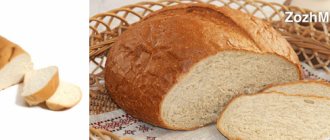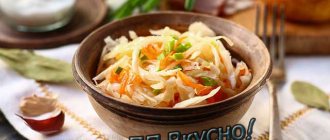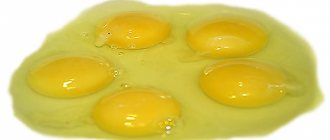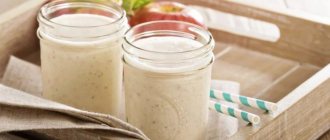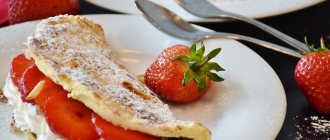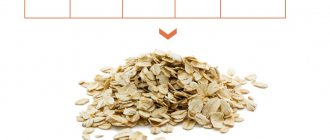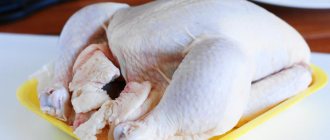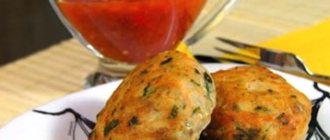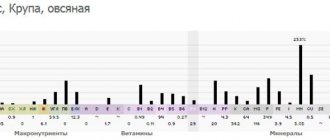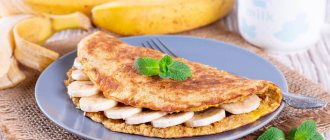Whole grain bread is easy to recognize in a store among other types of bread by its appetizing appearance, because the product is decorated with numerous whole grains. The calorie content of grain bread depends on its composition and the ratio of auxiliary components. Most often, this type of baked goods is made from corn, barley, rice and other grains. You can often find grain mixes. Many manufacturers add pumpkin to this bread and sprinkle seeds on top.
- Calorie content of whole grain bread
- Nutritional value of whole grain bread
- Composition of grain bread
- Useful properties of grain bread
- Harmful properties of the product
What is whole grain bread?
Whole grain bread is bread made from partially or fully milled flour from whole or nearly whole wheat grains.
Unlike the usual white bread, whole grain bread is baked from flour based on whole grains, containing, in addition to endosperm, germ and bran. Bran is rich in fiber, some minerals and antioxidants, and the germ is the main source of vitamins from cereal plants. This is why whole grain bread is considered healthier than white bread.
Not only wheat can be used as a grain for making whole grain flour. Manufacturers often add millet, corn, rye and oats, as well as some other grains.
Externally, the product is not very different from ordinary bread; it may have a darker color and a rougher structure.
However, be sure to read the product label to determine its true composition. The presence of a topping of seeds, poppy seeds or caraway seeds, or bran does not say anything about the flour that is used as the basis for making bread. In this way, manufacturers only artificially add naturalness to their product.
Whole grain bread is made from whole or nearly whole grains, which are rich in nutrients. This product is much healthier.
Properties of grain bread
Nutritional value and composition | Vitamins | Minerals
How much does grain bread cost (average price for 1 piece)?
Moscow and Moscow region.
50 rub.
From time immemorial, bread and bakery products have been part of the diet of the vast majority of the population of planet Earth. There is a huge variety of bread and bakery products. Bread is baked from various types of flour, obtained both from well-known cereal crops and from exotic plants.
Bread is a food product that is made by cooking dough at high temperatures. There are two constants in any type of bread: flour and water. When making bread, baker's yeast, baking powder, salt, sugar, other spices and herbs, as well as various flavoring additives are used.
It is worth noting that researchers have found confirmation of the fact that people began to bake the first bread in a primitive way in the Neolithic. This period dates back to 9500 BC. Ancient people baked bread using an open fire. The first bread contained grains that were soaked in flour. It is noteworthy that grain bread enjoys constant popularity and demand to this day.
In addition, grain bread is considered an incredibly healthy food product, which is used in dietary and medicinal nutrition menus. The uniqueness of grain bread lies in the fact that whole grains are used to prepare the product. Moreover, the grains used in the process of preparing this type of bread are not first ground into flour.
Composition and calorie content
The ratio of nutrients directly depends on the type of grain used. The “average” whole grain bread contains:
- alimentary fiber;
- vitamins (A, C, group B);
- minerals (manganese, phosphorus, zinc, iron, copper, magnesium);
- proteins;
- antioxidants (phytic and ferulic acids, lignans).
Fiber supports digestion, proteins serve as important building materials, and antioxidant compounds prevent the development of malignant tumors and some chronic diseases.
Whole grain bread has a low calorie content (247 calories per 100 grams) and an average glycemic index (about 40-50). For comparison: the glycemic index of white bread is 70.
The product contains valuable biologically active substances, has low energy value and is not dangerous for people with diabetes.
Concept
Whole grain bread is made from unrefined flour. This means that before grinding the grains, the outer layer, which contains useful valuable components, is not removed. And if the flour is white, then only the endosperm of the seed is ground. During its production, the husk (bran) and germ are sifted out, after which no useful components remain in the flour.
Usually rye flour is used to prepare products. It makes delicious whole grain bread. Calorie content per 100 g is 190 kcal. The product is heavy and lumpy with a grey-brown color. It retains freshness and moisture for a long time. The product does not crumble.
Contraindications
Whole grain bread is not a harmless product. In some cases it can be harmful to health. The main contraindications are:
- Gluten intolerance. Whole rye, wheat, barley are sources of protein (gluten), which about 1-5% of the world's population cannot tolerate. Such people, when taking whole grain products, develop a lot of unpleasant symptoms: from fatigue and joint pain to severe dyspeptic disorders.
- Irritable bowel syndrome. Some grains (such as wheat) contain short-chain fatty acids, which increase the symptoms of this disease.
When taking the product, chronic diseases of the stomach and duodenum (chronic gastritis or gastroduodenitis, peptic ulcer) may worsen. Whole grain bread can cause microdamage to the mucous membranes and also increase the acidity of gastric juice.
Bread, in the absence of the contraindications described above, can be safely consumed during pregnancy and breastfeeding.
Including whole grain bread in the diet (especially on a regular basis) requires careful assessment of your health status in order to eliminate risks.
So, myth 1. There is nothing in bread except flour and calories.
It is not true. Bread consists of flour, which is made from grains. If the bread is whole grain, then it is generally a storehouse of vitamins B-1, B-2, B-5, B-6, B-9, it contains manganese, molybdenum, silicon, copper, cobalt, selenium, phosphorus, which is important for preserving youth and zinc. If you ate one hundred grams of such bread, you provided the body with 1/3 of the daily requirement of magnesium, which protects the nervous system from stress. Finally, bread contains fiber, which is important for normalizing intestinal microflora, which, in turn, creates immunity.
Bread made from rye flour is the most useful - it contains more dietary fiber. In addition, according to the words, such bread cannot be prepared without acidifying the dough with sourdough. Therefore, the technology for making rye dough involves both alcoholic and lactic acid fermentation with the formation of organic acids necessary for the body, which contribute to the development of “useful” microflora.
How to choose it in the store?
Purchasing truly healthy bread in a store is not an easy task. Let's consider the key subtleties of choice:
- Whole grain flour content. Many modern manufacturers add only a small amount of whole grain flour and immediately change the name. Its optimal content is 99-100%.
- Secondary products. Quality bread should not contain thickeners, modified starch, azodicarbonamide, calcium propionate, sodium benzoate, soy flour and soy protein isolate. The presence of natural preservatives (for example, ascorbic acid) is allowed.
- Amount of fiber. 100 grams of bread should contain at least 8-12 grams of dietary fiber. Fiber should be natural (from whole grains), and not from other sources, such as inulin.
- Proportion of sugar and salt. An abundance of sugar makes the product tastier, but reduces biological potential; excess salt can adversely affect cardiovascular health. The optimal content of sodium chloride and sugar in 100 grams of bread is 200 mg and 2 grams, respectively.
- Appearance. Whole grain bread is always sealed. The cuts or crust often contain whole grains. The color is determined by the composition and can be anything.
- Consistency . Whole grain bread is dense to the touch and a little rough. A soft and fluffy product (with adequate composition) always costs 2-3 times more.
Simple tips will help you choose truly natural bread that is healthy.
Calorie content
Among baked goods, whole grain bread contains a large amount of vitamins. Its calorie content depends on the flour used. The product is rich in vitamins E, B3, as well as many microelements. It contains coarse fiber and complex carbohydrates.
If it is whole grain wheat bread, its calorie content is 246 kcal. This product is chosen to maintain slimness. Sometimes manufacturers add other components to it - seaweed, onions, garlic, dried fruits. There is also whole grain rye bread. Its calorie content is 190 kcal. This figure may vary depending on additional products.
How to do it at home?
Consider a simple recipe for making whole grain bread. It cooks quickly and does not require rare ingredients.
Required:
- 400 grams of whole grain flour (any);
- 20 grams of dry yeast;
- 300 ml warm water;
- 1 tbsp. l. salt;
- 1 tsp. Sahara;
- to taste – sesame seeds, rosemary, Provençal herbs;
- 30-40 grams of butter (for greasing the mold).
Preparation:
- Gently and consistently mix all ingredients until smooth.
- Pour water in a thin stream, constantly kneading the dough. It should turn out loose.
- Place the mixture in a container and cover with a towel or cling film. Let stand for 1 hour in a warm place.
- Prepare a baking dish. It should be evenly greased with butter.
- Transfer the dough into the mold. Sprinkle with sesame seeds.
- Place in an oven preheated to 200°C for 35-40 minutes. After the cooking cycle has finished, allow to cool in the oven for about 30 minutes. It is not recommended to open the door. Natural bread is ready.
Instead of warm water, you can use kefir or fermented baked milk.
The resulting product is light and soft. Pairs perfectly with any vegetables and herbs.
Making your own whole grain bread is easy. The main thing is to choose high-quality and natural ingredients.
Myth 6th. White bread is bad for you
It contains less fiber and vitamins than black and gray bread, or whole grain bread. But white bread made from flour of the first and highest grade can be recommended
for people who, according to indications, need easily digestible food (for example, after surgery on the digestive organs). Or people with gastritis or ulcers, because for them black bread can cause heartburn or pain.
White bread is recommended to be consumed yesterday, since freshly baked bread will also cause problems for people with chronic diseases.
Admission Tips
It is equally important to use and store bread correctly. Let's dwell on the main subtleties:
- When is the best time to eat? It is better not to take whole grain bread on an empty stomach or at night. This can negatively impact your stomach health and disrupt your sleep. It is recommended to take the product in the middle of the day.
- What to combine with. Bread goes well with vegetables, herbs (lettuce, cilantro), as well as lean meat.
- As much as possible per day. It is not recommended to consume more than 200-300 grams of product per day. Excess intake (if the daily energy value is exceeded) can disrupt intestinal function and lead to obesity.
- How to store. The bread will retain its properties better when tightly wrapped in cooking paper at room temperature (up to 7-10 days) or in an airtight container in the refrigerator (up to 5-10 days).
Proper consumption of whole grain bread will allow you to enjoy the exquisite taste and get exceptional benefits from it.
Harm
Due to the large fractions of wholemeal flour, bacteria penetrate the body and do not die during baking. Because of this, disturbances in the intestinal microflora may appear, and this leads to poor digestion.
Whole grain bread is considered rough on digestion. When the intestines and stomach are healthy, this exercise will be beneficial for them. But if there are any diseases, this can cause indigestion. But for a healthy body, such products will be healthier than those made from premium flour. When consumed in moderation, whole grain bread will not harm anyone. The calorie content of one piece is about 123 kcal.
What kind of bread can be used on a diet?
In the fight against excess weight, you need to give preference to bran bread and yeast-free bread. Bread with bran will cleanse the intestines well and normalize its functioning. Due to this, the weight loss effect quickly becomes visible. However, it is not recommended to eat this bread too often. Otherwise, you may have stomach problems.
Yeast-free bread is also a good alternative to loaf and even rye bread. In baked goods, yeast is the most unhealthy ingredient. They negatively affect the digestive system and also create an acidic environment in the body, which helps the development of infections and bacteria. Therefore, yeast-free bread is not only low-calorie, but also healthier.
If you still want to eat white bread, then you need to dry it in a toaster or let it get a little stale in natural conditions. The most harmful and high-calorie bread is freshly baked bread.
How to burn calories from 100 g of white wheat bread
For example, to burn all the calories from 100 grams of white wheat bread, you will need 22 minutes of running or 4 hours 21 minutes of sleep.
- Activity
- Calorie content per day g 100 per
| Dream | 4 hours 21 minutes | 18% |
| Meditation | 3 hours 54 minutes | 16% |
| Rest | 3 hours 34 minutes | 15% |
| Reading books, Internet | 3 h 00 min | 13% |
| Sex | 1 hour 52 minutes | 8% |
| Yoga, Pilates | 1 hour 13 minutes | 5% |
| Dancing | 1 h 09 min | 5% |
| Walking | 1 h 01 min | 4% |
| Football | 0h 37 min | 3% |
| Swimming | 0 h 35 min | 2% |
| Abs workout | 0h 32 min | 2% |
| Power training | 0h 32 min | 2% |
| A ride on the bicycle | 0h 29 min | 2% |
| Jumping rope | 0h 23 min | 2% |
| Run | 0h 22 min | 2% |
Corn bread
Calories:
330 kcal / 100 g.
Despite the fact that this bread ranks first in the selection in terms of calorie content, it is good for health, and nutritionists even recommend it for mild forms of diabetes.
Photo: istockphoto.com
Corn bread is rich in B vitamins, as well as magnesium, calcium, and potassium, because the flour goes through fewer sorting and purification steps. It also contains a lot of fiber and helps normalize the functioning of the pancreas.
Calorie table for bread and bakery products
© Serghei Velusceac — stock.adobe.com
Share:
In order to keep yourself in shape, you just need to count calories. Of course, for each person there is an individual indicator of the required KBZHU. The table of calorie content of bread and bakery products will help you take into account calories even when you just “snacked on a bun” or ate a piece of bread at school or at work.
| The product's name | Calorie content, kcal | Proteins, g per 100 g | Fats, g per 100 g | Carbohydrates, g per 100 g |
| Bagel | 339 | 7.9 | 9.4 | 55.5 |
| Baguette | 262 | 7.5 | 2.9 | 51.4 |
| Baranki | 336 | 16.0 | 1.0 | 70.0 |
| Loaf of Nareznoy | 264 | 7.5 | 2.9 | 50.9 |
| Baton Podmoskovny | 261 | 7.5 | 2.6 | 50.6 |
| Wheat bran loaf | 273 | 9.2 | 2.8 | 51.4 |
| Baton Capital | 243 | 7.7 | 0.8 | 50.2 |
| Pretzel | 300 | 20.0 | 6.0 | 35.0 |
| Brioche | 304 | 5.2 | 7.5 | 57.2 |
| Bruschetta | 315 | 4.7 | 23.0 | 21.7 |
| Bagel | 336 | 16.0 | 1.0 | 70.0 |
| Ukrainian bagel | 328 | 8.3 | 6.4 | 58.2 |
| Bagel Fair | 330 | 8.5 | 7.0 | 58.3 |
| Bun for tea | 317 | 7.2 | 6.2 | 51.0 |
| Bun High in calories | 363 | 7.3 | 9.6 | 62.4 |
| Bran bun | 220 | 7.8 | 1.8 | 43.9 |
| Bun Stolichnaya | 270 | 8.4 | 2.2 | 52.8 |
| 8 grain buns | 277 | 13.9 | 5.3 | 43.7 |
| Burgundy buns | 266 | 0.7 | 1.7 | 55.0 |
| Sandwich buns with sesame seeds | 320 | 9.6 | 4.2 | 59.5 |
| Hamburger buns | 272 | 7.0 | 4.0 | 52.0 |
| Hot dog buns | 339 | 8.7 | 7.5 | 60.6 |
| Butter buns | 339 | 7.9 | 9.4 | 55.5 |
| Cheesecake with curd filling | 331 | 10.0 | 12.1 | 46.1 |
| Volovan | 435 | 7.9 | 29.9 | 35.9 |
| Wheat croutons | 390 | 11.4 | 9.0 | 65.7 |
| Wheat croutons lettuce cubes | 342 | 12.3 | 5.2 | 61.6 |
| Rye croutons with garlic | 239 | 9.5 | 12.5 | 22.1 |
| Grissini | 238 | 7.0 | 6.0 | 40.0 |
| Kalach | 249 | 7.9 | 0.8 | 51.6 |
| Loaf Festive | 276 | 7.7 | 6.3 | 45.9 |
| Pretzel | 338 | 8.2 | 3.1 | 69.3 |
| Croutons | 426 | 10.1 | 9.7 | 71.7 |
| Store-bought Easter cake | 331 | 5.5 | 15.8 | 43.3 |
| Armenian lavash | 236 | 7.9 | 1.0 | 47.6 |
| Armenian lavash Black Cuttlefish | 229 | 7.2 | 0.8 | 48.3 |
| Caucasian lavash | 274 | 8.1 | 0.7 | 57.1 |
| Lavash Fitness bran | 147 | 5.2 | 0.4 | 33.3 |
| Spinach pita bread | 220 | 7.2 | 0.8 | 48.3 |
| Rye flatbread | 376 | 8.0 | 18.3 | 44.2 |
| Uzbek flatbread with sesame seeds | 245 | 7.9 | 0.8 | 50.4 |
| Matzo | 312 | 10.5 | 1.3 | 69.9 |
| Pizza base Talosto | 274 | 2.9 | 2.4 | 54.4 |
| Palyanitsa Ukrainian | 246 | 7.9 | 0.9 | 50.2 |
| Dumplings | 215 | 5.8 | 3.9 | 41.9 |
| Dumplings with garlic | 299 | 8.6 | 3.3 | 58.8 |
| Pete | 242 | 7.4 | 0.8 | 49.9 |
| Pizza Casa Nostra Assorted | 261 | 11.4 | 8.5 | 29.8 |
| Pizza Casa Nostra Ham-Cheese | 235 | 8.5 | 7.2 | 29.6 |
| Pizza Casa Nostra Mushroom-Cheese | 203 | 9.4 | 4.7 | 29.2 |
| Pizza Ristorante Bolognese | 213 | 8.7 | 9.5 | 22.9 |
| Pizza Ristorante Calzone Speciale | 258 | 11.2 | 13.9 | 21.9 |
| Pizza Ristorante Formaggi and Pomodori | 232 | 7.7 | 11.6 | 23.9 |
| Pizza Ristorante Funghi | 235 | 7.8 | 12.3 | 22.9 |
| Pizza Ristorante Hawaii | 215 | 8.6 | 8.6 | 25.7 |
| Pizza Ristorante Mozzarella | 262 | 10.5 | 13.6 | 24.3 |
| Pizza Ristorante Pepperoni-Salame | 272 | 10.1 | 14.1 | 25.8 |
| Pizza Ristorante Piccola Mozzarella | 246 | 10.0 | 12.7 | 22.8 |
| Pizza Ristorante Piccola Salame | 264 | 10.0 | 13.5 | 25.4 |
| Pizza Ristorante Prosciutto | 228 | 10.1 | 10.1 | 24.1 |
| Pizza Ristorante Quattro Formaggi | 267 | 10.8 | 14.0 | 24.1 |
| Pizza Ristorante Salame | 273 | 10.4 | 14.0 | 26.3 |
| Pizza Ristorante Speciale | 255 | 10.0 | 13.3 | 23.5 |
| Pizza Ristorante Vegetale | 198 | 6.7 | 9.1 | 22.2 |
| Braided sesame | 267 | 7.9 | 2.7 | 51.5 |
| Braided with poppy seeds | 267 | 7.9 | 2.7 | 51.5 |
| Bun | 334 | 7.6 | 8.8 | 56.4 |
| Bun Moskovskaya | 330 | 7.6 | 8.7 | 57.2 |
| Donut | 296 | 5.6 | 13.0 | 38.8 |
| Bagel | 357 | 7.9 | 10.8 | 57.2 |
| Butter horns | 345 | 8.3 | 12.1 | 50.5 |
| Roti | 370 | 13.9 | 1.8 | 75.1 |
| May roll | 333 | 7.3 | 9.3 | 55.0 |
| Saika | 339 | 7.9 | 9.4 | 55.5 |
| Samsa with chicken | 325 | 11.0 | 24.0 | 17.0 |
| Baking Sormovskaya Cheryomushki | 348 | 7.6 | 9.2 | 58.6 |
| Slices | 370 | 7.0 | 7.9 | 74.7 |
| Wheat slices | 382 | 11.2 | 1.8 | 80.3 |
| White bread crackers | 331 | 11.2 | 1.4 | 72.2 |
| Rye crackers | 336 | 16.0 | 1.0 | 70.0 |
| Drying poppy seeds | 372 | 11.3 | 4.4 | 70.5 |
| Taco | 467 | 7.1 | 20.8 | 58.1 |
| Salad tartlets | 514 | 9.1 | 30.9 | 48.3 |
| Tortilla (Mexican Tortillas) | 286 | 7.0 | 7.7 | 47.2 |
| Corn tortilla | 218 | 5.7 | 2.8 | 44.6 |
| Wheat tortilla | 327 | 8.4 | 8.3 | 54.6 |
| Cheese tortilla | 270 | 6.7 | 7.0 | 45.0 |
| Snack rolls | 219 | 4.3 | 12.4 | 22.4 |
| Fatir | 245 | 7.9 | 0.8 | 50.4 |
| Focaccia | 320 | 7.7 | 10.7 | 47.3 |
| 8 Grain Bread | 269 | 13.7 | 5.2 | 42.0 |
| Bread Leinsamenbrot | 189 | 5.2 | 3.1 | 30.9 |
| English grain bread | 300 | 13.3 | 8.8 | 40.9 |
| Banana bread | 326 | 4.3 | 10.5 | 53.5 |
| Bauerbrot bread | 252 | 8.0 | 2.5 | 49.6 |
| Bogorodsky yeast-free bread | 221 | 6.9 | 1.2 | 43.4 |
| Bogorodsky custard bread | 189 | 6.2 | 0.8 | 41.8 |
| Bread Borodinsky | 208 | 6.9 | 1.3 | 40.9 |
| Boyarsky bread | 232 | 6.9 | 1.3 | 48.3 |
| Bread Bourget multigrain | 225 | 7.6 | 2.6 | 41.6 |
| Bread Vysivkovy | 217 | 9.0 | 2.2 | 36.0 |
| Hercules grain bread | 289 | 10.1 | 5.4 | 49.0 |
| Hercules milk bread | 277 | 10.4 | 2.7 | 51.6 |
| Hercules bread with bran | 279 | 9.7 | 6.4 | 44.7 |
| Bread Gornyatsky | 136 | 6.8 | 1.1 | 36.7 |
| Mustard Bread | 269 | 7.1 | 4.8 | 48.3 |
| Buckwheat bread | 228 | 7.1 | 2.5 | 45.8 |
| Bread Darnitsky | 206 | 6.6 | 1.1 | 41.0 |
| Bread Darnitsky tin | 210 | 6.5 | 1.5 | 41.0 |
| Dvinsky flavored bread | 214 | 6.7 | 2.7 | 42.7 |
| Bread Noble | 238 | 9.2 | 9.5 | 28.8 |
| Country Bread | 203 | 6.8 | 1.2 | 41.2 |
| Donskoy bread | 219 | 7.1 | 0.9 | 44.0 |
| Old Russian grain bread | 252 | 9.6 | 2.7 | 47.1 |
| Elizabeth waffle bread | 368 | 11.4 | 3.5 | 70.7 |
| Elizaveta waffle bread iodized | 368 | 11.4 | 3.5 | 70.6 |
| Elizabeth waffle corn bread | 368 | 10.9 | 3.6 | 71.2 |
| Elizaveta rye waffle bread | 370 | 11.1 | 4.4 | 70.1 |
| Elizabeth waffle bread with vitamins and iron | 368 | 11.4 | 3.5 | 70.6 |
| Elizabeth waffle bread with onions | 365 | 11.4 | 3.5 | 70.4 |
| Waffle bread Elizaveta with spices | 366 | 11.3 | 3.5 | 70.4 |
| Elizabeth waffle bread with garlic | 364 | 11.3 | 3.5 | 70.2 |
| Elizabeth waffle pumpkin bread with bran | 358 | 13.8 | 4.3 | 64.2 |
| Castle bread new | 227 | 6.5 | 0.6 | 47.6 |
| Bread Ideal figure | 273 | 9.3 | 6.3 | 43.6 |
| Kaiser bread | 200 | 6.0 | 2.5 | 40.0 |
| Karelian bread | 220 | 7.5 | 1.2 | 37.0 |
| Kernbrot German whole grain bread | 222 | 6.5 | 4.0 | 39.3 |
| Kefir bread | 275 | 7.9 | 4.1 | 50.5 |
| Peasant bread | 193 | 6.2 | 0.9 | 40.2 |
| Corn bread | 266 | 6.7 | 7.1 | 43.5 |
| Merchant Bread | 196 | 4.6 | 0.9 | 42.5 |
| Oat bread | 226 | 7.1 | 3.2 | 40.8 |
| Bread Festive | 449 | 10.3 | 14.1 | 70.4 |
| Pryazhenik rye bread with whole grains | 198 | 7.8 | 1.0 | 39.6 |
| Wheat bread | 242 | 8.1 | 1.0 | 48.8 |
| Rye-wheat bread | 222 | 8.1 | 3.4 | 42.2 |
| Rye bread | 250 | 13.0 | 3.0 | 40.0 |
| Rye bread | 217 | 5.9 | 1.1 | 44.5 |
| Bran bread | 227 | 7.5 | 1.3 | 45.2 |
| Bread with seeds | 302 | 10.5 | 10.1 | 43.3 |
| Bread with dried fruits | 253 | 11.0 | 4.0 | 43.0 |
| Selyanochka bread | 270 | 8.9 | 4.0 | 49.6 |
| Soy bread | 282 | 52.0 | 1.2 | 17.4 |
| Malt bread | 236 | 7.5 | 0.7 | 50.6 |
| Bread Capital | 210 | 7.0 | 1.2 | 45.8 |
| Table Bread | 214 | 6.9 | 1.2 | 43.2 |
| Bread Tonus | 212 | 8.0 | 2.0 | 40.0 |
| Toast bread | 285 | 7.3 | 3.9 | 52.5 |
| Ukrainian bread | 198 | 6.6 | 1.2 | 39.6 |
| Challah bread | 265 | 7.9 | 2.6 | 51.0 |
| Garlic bread | 323 | 20.3 | 2.1 | 55.5 |
| Ciabatta bread | 262 | 7.7 | 3.8 | 47.8 |
| Cippolino bread | 269 | 8.3 | 2.5 | 53.3 |
| Grazione dietary breadsticks with spinach | 356 | 11.7 | 3.2 | 71.2 |
| Manifesto simple breadsticks | 404 | 11.0 | 6.8 | 74.8 |
| Manifesto sesame bread sticks | 404 | 11.0 | 6.8 | 74.8 |
| Manifesto breadsticks with poppy seeds | 404 | 11.0 | 6.8 | 74.8 |
| Manifesto bread sticks with rye flavor | 404 | 11.0 | 6.8 | 74.8 |
| Manifesto breadsticks with salt | 404 | 11.0 | 6.8 | 74.8 |
| Manifesto breadsticks with cheese | 404 | 11.0 | 6.8 | 74.8 |
| Di&Di amaranth bread with onions | 330 | 7.9 | 1.7 | 69.0 |
| Dr.Korner Buckwheat bread with vitamins | 320 | 12.0 | 3.0 | 52.0 |
| Crispbread Dr.Korner Cranberry cereal shake | 320 | 9.0 | 2.0 | 66.0 |
| Dr.Korner bread cereal honey cocktail | 320 | 9.0 | 2.0 | 66.0 |
| Dr.Korner Crispbread Blueberry Cereal Shake | 320 | 9.0 | 2.0 | 66.0 |
| Dr.Korner Corn and Rice Crispbread with Provençal Herbs | 300 | 8.0 | 3.0 | 59.0 |
| Bread Dr.Korner Seven grains | 290 | 10.0 | 2.0 | 57.0 |
| Crispbread Fazer Mixed vegetables cabbage and carrots | 253 | 9.5 | 5.6 | 40.3 |
| Finn Crisp Caraway with caraway | 360 | 11.0 | 2.4 | 60.0 |
| Finn Crisp Codiander Borodino bread | 370 | 11.0 | 2.9 | 62.0 |
| Finn Crisp Garlic bread with garlic | 380 | 11.0 | 4.4 | 61.0 |
| Finn Crisp Multigrain crispbread | 380 | 12.0 | 4.8 | 60.0 |
| Finn Crisp Original rye bread | 360 | 11.0 | 2.4 | 60.0 |
| Fitness rye-wheat bread | 299 | 10.5 | 1.9 | 59.6 |
| Waffle bread | 368 | 11.4 | 3.5 | 70.9 |
| Doctor's bread | 242 | 8.2 | 2.6 | 46.3 |
| Italian bread Baker House vegetable mix | 290 | 6.0 | 16.0 | 30.0 |
| Baker House Italian bread with rosemary and garlic | 250 | 6.0 | 8.5 | 38.0 |
| Baker House Italian bread with celery and flax seeds | 320 | 7.0 | 13.0 | 44.0 |
| Baker House Italian bread with sunflower seeds | 300 | 8.0 | 14.0 | 35.0 |
| Baker House Italian crispbread with pumpkin seeds | 240 | 6.0 | 8.0 | 37.0 |
| Baker House Italian bread with tomato and oregano | 300 | 6.0 | 12.0 | 42.0 |
| Croisette wheat bread | 374 | 13.3 | 4.7 | 69.7 |
| Croisette rye-wheat bread | 382 | 12.8 | 4.9 | 71.9 |
| Croisette bread rye-wheat with sesame | 397 | 13.7 | 9.2 | 65.0 |
| Croisette bread rye-wheat with onions | 374 | 13.3 | 4.7 | 69.7 |
| Croisette bread rye-wheat with cheese | 428 | 16.9 | 9.2 | 69.4 |
| Croisette rye bread | 300 | 14.5 | 2.3 | 55.4 |
| Rye bread | 310 | 11.0 | 2.7 | 58.0 |
| Rice cakes | 310 | 6.0 | 1.0 | 69.0 |
| Whole grain bread | 295 | 10.1 | 2.3 | 57.1 |
| Molodtsy light rye waffle bread | 345 | 10.1 | 4.8 | 65.3 |
| Chapati | 370 | 13.8 | 1.9 | 75.2 |
| Shangi | 270 | 5.9 | 9.1 | 41.9 |
| Yufka | 441 | 7.0 | 20.0 | 48.0 |
You can download the table so you can always use it here.
Rate the material
Share:
Author Ivan Tungusov
Project expert. Training experience - 12 years. A good theoretical basis on the training process and proper nutrition, which I am happy to put into practice. Need a recommendation? This is for me 
Editorial team cross.expert
Borodino bread
Calories:
210 kcal / 100 g.
Photo: istockphoto.com
Most often, the finished loaf of bread is sprinkled with spices (coriander or cumin), which gives it a spicy taste and a characteristic aroma. Therefore, Borodino bread is often distinguished from others. If we talk about beneficial properties, it improves metabolism and normalizes the functioning of the gallbladder and liver.
Micro- and macroelements in Bread
Bread contains the following elements: Mono- and disaccharides, Ash, Starch, Water, Organic acids, Dietary fiber, Sodium, Potassium, Phosphorus, Magnesium, Calcium, Sulfur, Copper, Iodine, Manganese, Chromium, Molybdenum, Cobalt, Zinc, Iron, Chlorine.
- Micro and macro element
- Meaning
| Mono- and disaccharides, g. | 1,4 |
| Zola, Mr. | 2,1 |
| Starch, Mr. | 36,3 |
| Water, city | 42,6 |
| Organic acids, g. | 0,9 |
| Dietary fiber, g. | 1,2 |
| Sodium, mg | 400 |
| Potassium, mg | 244 |
| Phosphorus, mg | 194 |
| Magnesium, mg | 57 |
| Calcium, mg | 33 |
| Sulfur, mg | 56 |
| Copper, µg | 183 |
| Iodine, mcg | 3,2 |
| Manganese, mg | 0,98 |
| Chromium, µg | 3 |
| Molybdenum, mcg | 10,3 |
| Cobalt, µg | 2 |
| Zinc, mg | 1,07 |
| Iron, mg | 4,5 |
| Chlorine, mg | 680 |
Oat bread
Calories:
210 kcal / 100 g.
The benefits of such bread are explained by the properties of oatmeal, which not only gives lightness, but also contains a complex of vitamins, including groups A, B, C. Oatmeal bread is considered a dietary product, as it contains a large amount of fiber, which cleanses the body and improves metabolic processes .
Bread is not the head of everyone: what will happen if you give up flour
White bread: history of origin
The Egyptians, Greeks and Romans improved the recipe for white bread every day and by the beginning of our era, a unified technology for making bread was created. This technology has spread throughout the world and is widely used in the 21st century.
In Greece, white bread was very expensive; only nobles bought it. It became an independent dish and was served separately. Rich hosts treated their guests to freshly baked delicacies and herbal tea.
Over time, the fragrant humpback became available to ordinary people. Baking was treated with respect and medicinal properties were attributed: colds were treated with fresh bread, and the stomach and intestines were treated with stale slices. Eating food without bread was considered a huge sin, for which the gods must punish a person.
In India, local authorities punished thieves, robbers and murderers by not giving them even a piece of bread for a long period of time. The more serious the crime, the longer the culprit remained without sacred food. Not respecting and not honoring bread was one of the most terrible insults of those times.
Conveyor ovens, dough mixing machines and other equipment have made the process of preparing flour products easier, but there are also those who like to prepare baked goods at home. Grandmothers' and mothers' own authentic confectionery recipes, which are passed down from generation to generation, cannot compare with bread bought in a supermarket.
